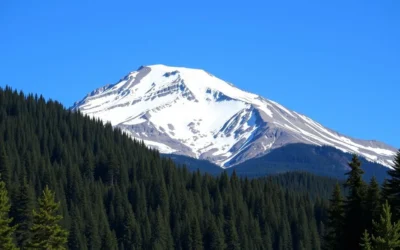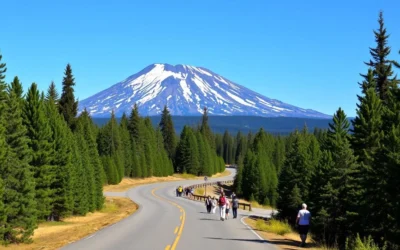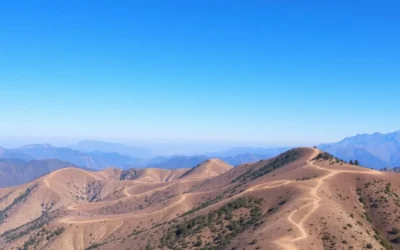Did you know Mojave National Preserve is home to the largest and densest Joshua Tree forest in the world? Spanning over 1.6 million acres (647,000 hectares), this vast desert wilderness is larger than the entire state of Rhode Island, offering visitors a remarkable diversity of landscapes from towering sand dunes to ancient lava flows. As the third largest unit in the US National Park System within the contiguous United States, this hidden gem of the California desert awaits your exploration.
Getting There & Planning Your Journey
Mojave National Preserve is located in southeastern California, nestled between Interstate 15 to the north and Interstate 40 to the south. The preserve is approximately 200 km (125 miles) northeast of Los Angeles and 96 km (60 miles) southwest of Las Vegas.
Nearest Airports
- Las Vegas Harry Reid International Airport (LAS) – 96 km (60 miles) northeast
- Ontario International Airport (ONT) – 193 km (120 miles) southwest
- Palm Springs International Airport (PSP) – 209 km (130 miles) south
Ready to Start Your Desert Adventure?
Find the best flight deals to Las Vegas or Ontario to begin your Mojave journey.
Unlike national parks, Mojave National Preserve has no entrance stations or fees. You can enter the preserve from multiple points, with the most common access routes being:
- From I-15: Exit at Baker, Cima Road, or Nipton Road
- From I-40: Exit at Kelbaker Road, Essex Road, or Goffs Road
Best Time to Visit Mojave National Preserve
The Mojave Desert experiences extreme temperature variations, making timing your visit crucial for comfort and safety.
Recommended Seasons (October-April)
- Fall (October-November): Pleasant daytime temperatures between 18-26°C (65-80°F) with cool evenings around 7-13°C (45-55°F)
- Winter (December-February): Mild days around 13-18°C (55-65°F) but cold nights that can drop below freezing. Occasional light snow is possible at higher elevations
- Spring (March-April): Comfortable temperatures ranging from 18-29°C (65-85°F) with potential wildflower blooms after winter rains
Seasons to Avoid (May-September)
- Summer (May-September): Extreme heat with daytime temperatures regularly exceeding 38°C (100°F) and sometimes reaching 49°C (120°F) at lower elevations
- July-August: Monsoon season brings potential for sudden thunderstorms and flash flooding
- Holiday weekends: The preserve can be busier during major holidays, especially in the cooler months
Pro Tip: If visiting during cooler months, be prepared for significant temperature drops after sunset. Even on mild days, desert nights can be surprisingly cold!
Getting Around Locally
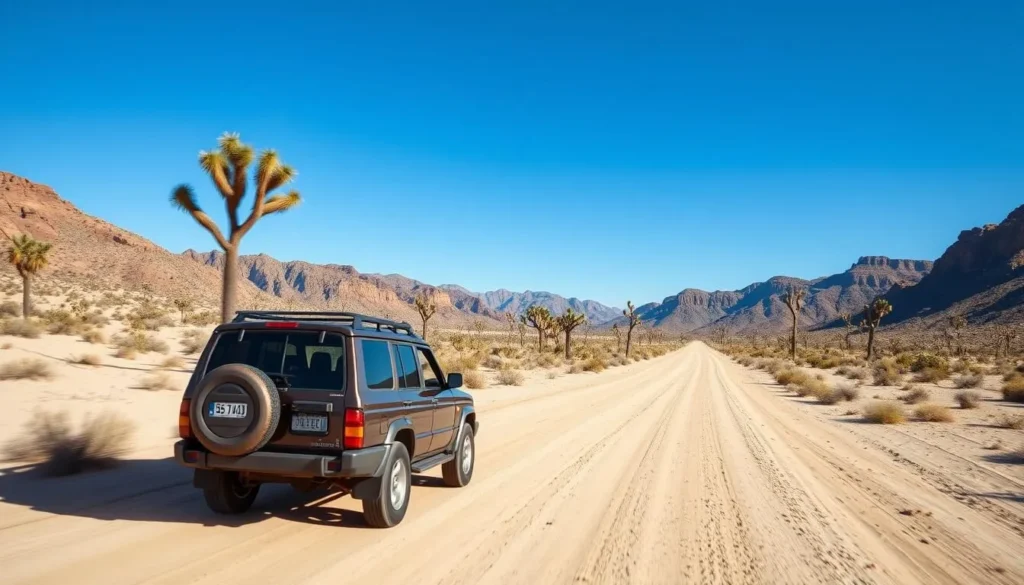
Navigating Mojave National Preserve requires careful planning as services are limited and distances between attractions can be significant.
Vehicle Requirements
While many of the preserve’s main attractions can be accessed via paved roads, a high-clearance vehicle is recommended for exploring more remote areas. Four-wheel drive is necessary for sandy or rough backcountry roads.
Important: There are NO gas stations within the preserve. Fill your tank before entering, and carry extra water and emergency supplies. Cell service is extremely limited throughout the preserve.
Road Conditions
- Paved Roads: Kelbaker Road, Kelso-Cima Road, and Cima Road are paved and generally accessible to all vehicles
- Improved Dirt Roads: Black Canyon Road and Cedar Canyon Road are typically passable in standard vehicles when dry
- Primitive Roads: Mojave Road and many other backcountry routes require high-clearance 4WD vehicles
Explore Mojave at Your Own Pace
Rent a reliable vehicle with good clearance to access the preserve’s most scenic spots.
Where to Stay
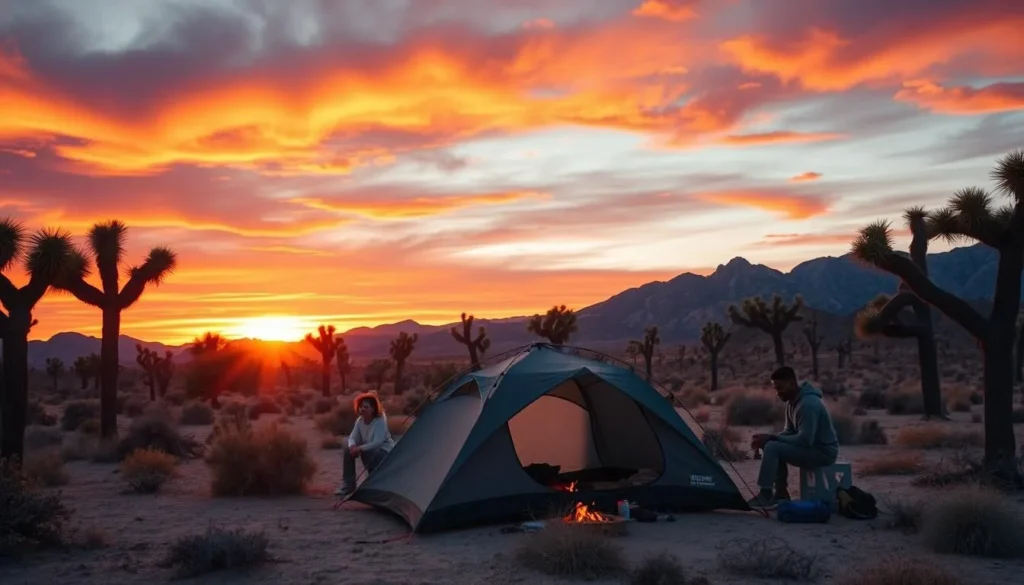
Accommodation options within and around Mojave National Preserve range from primitive camping to comfortable hotels in nearby towns.
Camping Within the Preserve
- Hole-in-the-Wall Campground: 35 sites with picnic tables, fire rings, vault toilets, and potable water. $12 per night, first-come, first-served
- Mid Hills Campground: 26 sites at a higher elevation (1,700 m/5,600 ft), offering cooler temperatures. $12 per night, first-come, first-served
- Dispersed Camping: Allowed throughout much of the preserve at no cost. Must use existing fire rings and camp at least 200 m (650 ft) from water sources
Nearby Accommodations
- Baker: Limited motel options along I-15 at the northern edge of the preserve
- Primm: Casino hotels offering affordable rooms about 72 km (45 miles) from the preserve’s northern boundary
- Barstow: Various hotels and motels approximately 97 km (60 miles) west of the preserve
- Twentynine Palms: Accommodation options near Joshua Tree National Park, about 129 km (80 miles) south
Find Your Perfect Desert Retreat
Book accommodations in advance, especially during peak season (October-April).
Dining & Local Cuisine
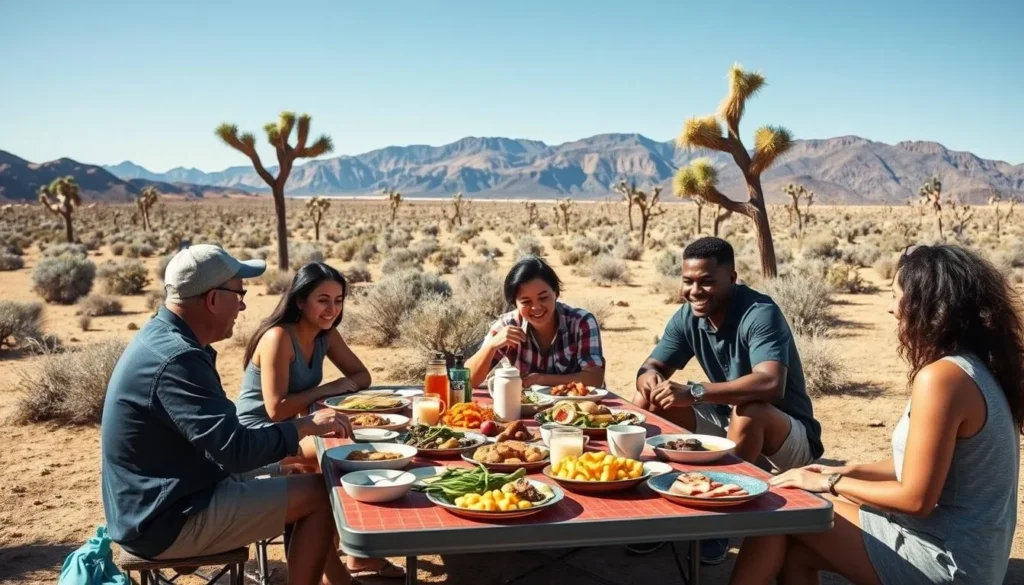
There are no restaurants or food services within Mojave National Preserve, making advance planning essential.
Food Planning Tips
- Bring All Supplies: Pack all food, water, and snacks you’ll need for your entire visit
- Water Requirements: Carry at least 4 liters (1 gallon) of water per person per day, more during hot weather
- Cooler Essentials: A good cooler with ice is vital for perishable foods, especially during warmer months
- Cooking Equipment: If camping, bring a portable stove, as fire restrictions are common during dry periods
Nearby Dining Options
- Baker: Fast food restaurants, convenience stores, and The Mad Greek Café (known for gyros and milkshakes)
- Nipton: Nipton Trading Post offers basic supplies and snacks
- Primm: Several dining options in the casino hotels
- Barstow: Wide range of restaurants including local diners and chain establishments
Local Tip: The Mad Greek Café in Baker is a popular stop for travelers between Las Vegas and Los Angeles, known for its unique blend of Greek and American diner food.
Top Attractions & Activities in Mojave National Preserve
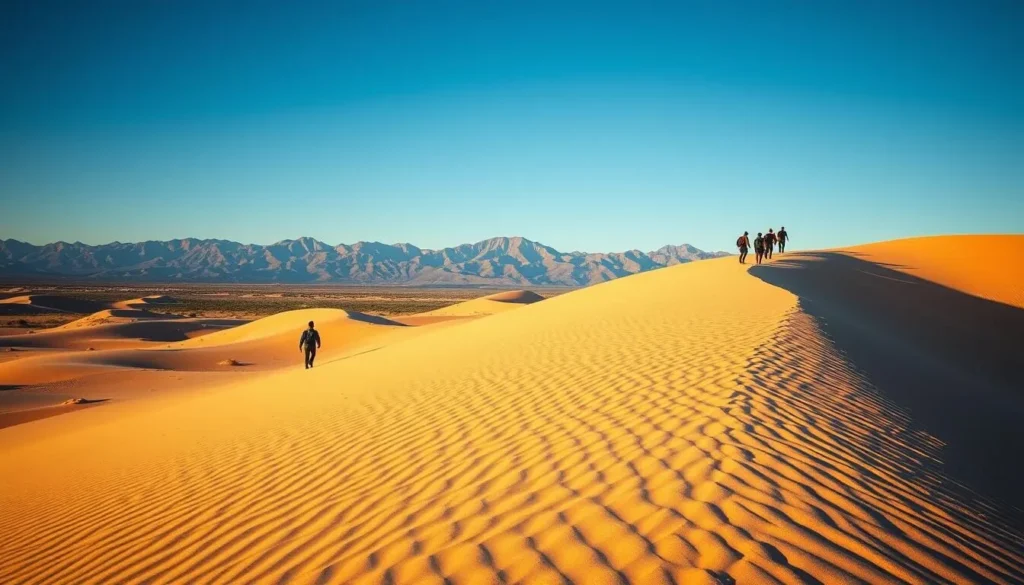
Mojave National Preserve offers a remarkable diversity of desert landscapes and experiences. Here are the must-see attractions that showcase the best of this vast wilderness.
1. Kelso Dunes
Rising 183 m (600 ft) above the desert floor, these massive sand dunes cover 111 square km (45 square miles) and are among the most photogenic spots in the preserve. The 5 km (3-mile) round-trip hike to the summit is challenging but rewards with panoramic views. Listen for the famous “singing sand” phenomenon—a booming sound produced when sand slides down the steeper slopes.
2. Teutonia Peak Trail
This moderate 5 km (3-mile) round-trip hike takes you through the world’s densest Joshua Tree forest and up to a rocky summit with spectacular views of Cima Dome, a remarkable geological feature that rises gently from the desert floor. The trail also passes by abandoned silver mines, adding historical interest to the natural beauty.
3. Hole-in-the-Wall Rings Trail
This family-friendly 2.4 km (1.5-mile) loop trail showcases some of the preserve’s most unique geology. The path winds through volcanic rock formations riddled with holes and requires a fun scramble up metal rings bolted into the rock face. Look for ancient petroglyphs along the route.
4. Lava Tube
A short 0.8 km (0.5-mile) hike leads to an impressive lava tube formed by ancient volcanic activity. Bring flashlights to explore the 150 m (500 ft) tunnel with its dramatic ceiling openings that create stunning light beams during midday. The access road requires a high-clearance vehicle.
5. Cinder Cones National Natural Landmark
This volcanic field contains 32 cinder cones and vast lava flows, creating an otherworldly landscape. The area is accessible via Aiken Mine Road, though a high-clearance vehicle is recommended.
Enhance Your Desert Experience
Discover guided tours and activities that will help you make the most of your Mojave adventure.
Historical & Cultural Sites
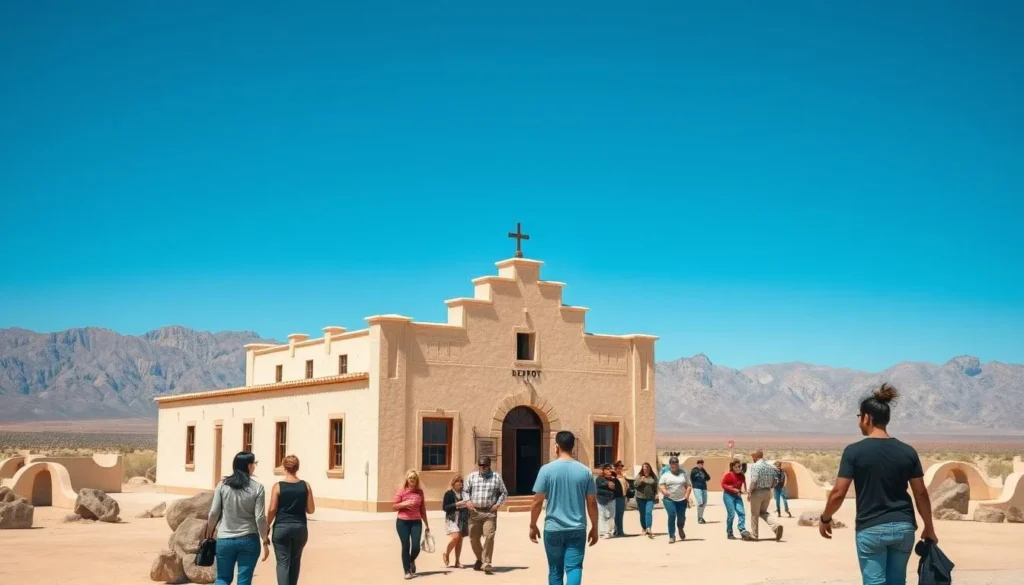
Beyond its natural wonders, Mojave National Preserve preserves fascinating chapters of human history, from ancient indigenous cultures to pioneering railroads and mining operations.
Kelso Depot Visitor Center
This beautifully restored Spanish Mission Revival style railroad depot was built in 1924 and once served as a crucial stop for the Union Pacific Railroad. Today, it houses exhibits on the natural and cultural history of the region. While currently closed for repairs until 2025, the exterior remains an impressive photo opportunity.
Rock Springs Land Company Building
This historic stone cabin along the Rock Spring Trail dates back to the 1920s and was once home to World War I veterans who homesteaded in the area. The short trail also leads to a natural spring that has attracted humans for thousands of years.
Mojave Cross
Located near Cima Road, this memorial was erected in 1934 to honor World War I veterans. After a lengthy legal battle regarding religious symbols on public land, the site was transferred to private ownership while remaining accessible to visitors.
Providence Ghost Town
Little remains of this once-bustling mining town that flourished in the late 1800s, but history enthusiasts can still find scattered ruins and mining equipment. Access requires high-clearance vehicles and hiking.
“The Mojave Desert has been home to humans for at least 12,000 years, with the Chemehuevi, Mojave, and other indigenous peoples developing sophisticated adaptations to this challenging environment long before European contact.”
Outdoor Experiences & Wildlife
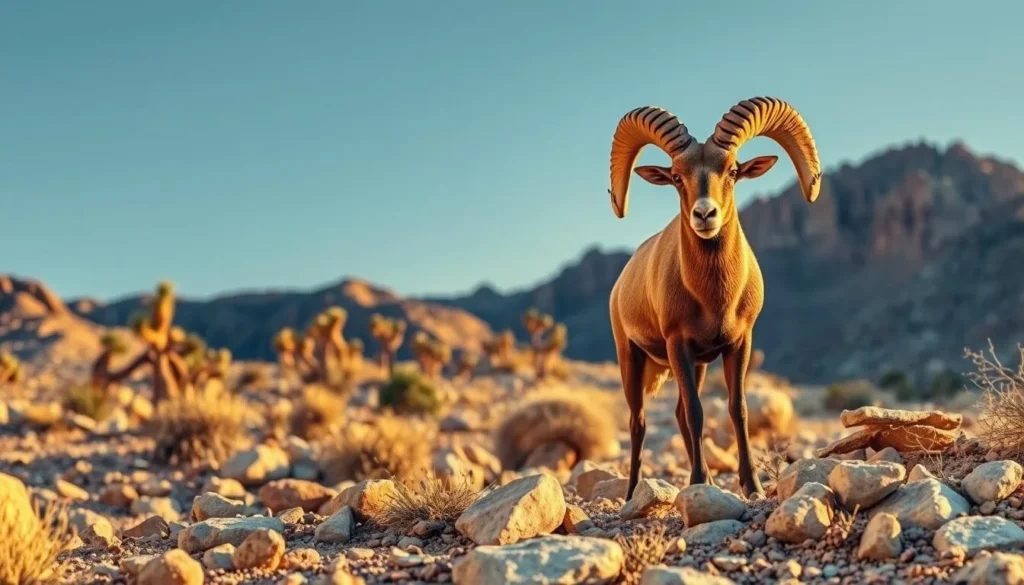
The seemingly harsh desert environment of Mojave National Preserve supports a surprising diversity of plant and animal life, offering excellent opportunities for wildlife viewing and stargazing.
Wildlife Viewing
The preserve is home to desert bighorn sheep, desert tortoises, jackrabbits, roadrunners, and numerous reptile species. Dawn and dusk offer the best wildlife viewing opportunities. Keep a respectful distance and never approach or feed wild animals.
Plant Communities
Beyond the iconic Joshua Trees, look for barrel cacti, Mojave yucca, creosote bush, and spectacular wildflower displays after winter rains. The preserve spans several ecological zones, from creosote bush scrub at lower elevations to pinyon-juniper woodlands in the mountains.
Night Sky Viewing
With minimal light pollution, Mojave National Preserve offers exceptional stargazing opportunities. The Hole-in-the-Wall and Mid Hills campgrounds are excellent locations for night sky photography and astronomy.
Photography
The preserve’s diverse landscapes provide endless photographic opportunities. The golden hours around sunrise and sunset offer the most dramatic lighting, especially at Kelso Dunes and Cima Dome.
Photography Tip: A polarizing filter can help reduce glare and enhance the vibrant colors of the desert landscape, especially during midday hours.
Safety, Etiquette & Local Customs
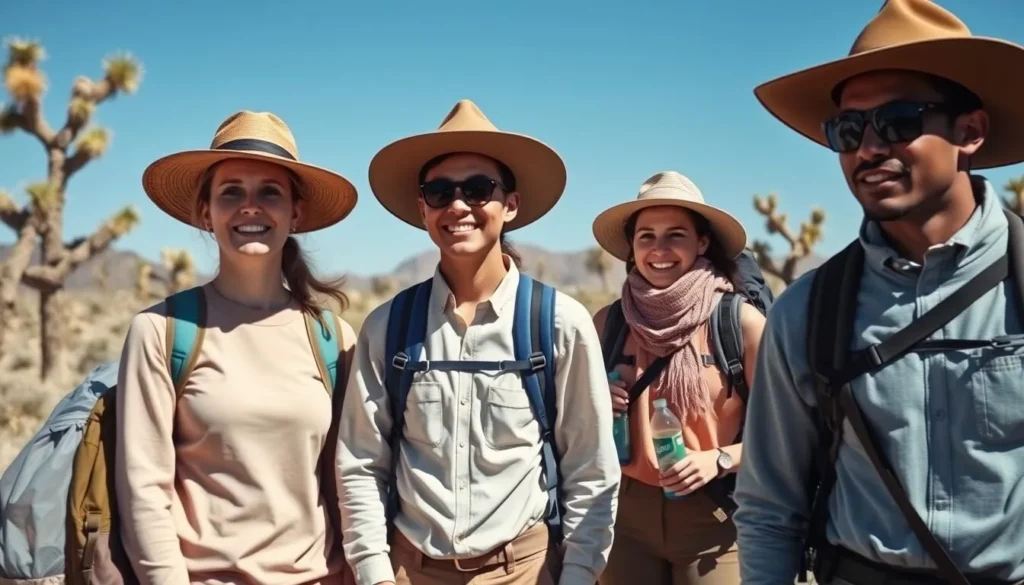
The desert environment presents unique challenges that require proper preparation and respect for both the natural environment and cultural heritage.
Desert Safety Essentials
- Water: Carry at least 4 liters (1 gallon) per person per day, more in hot weather
- Navigation: Bring physical maps as GPS and cell service are unreliable
- Sun Protection: Wear a wide-brimmed hat, sunglasses, and sunscreen
- Clothing: Dress in layers, as temperatures can vary dramatically between day and night
- Vehicle Preparedness: Carry a spare tire, jack, extra food, water, and emergency supplies
Environmental Etiquette
- Stay on designated roads and trails to protect fragile desert soils and vegetation
- Practice Leave No Trace principles by packing out all trash
- Respect wildlife by observing from a distance and never feeding animals
- Preserve cultural resources by not touching petroglyphs or removing artifacts
- Use established fire rings and check for fire restrictions before your visit
Flash Flood Warning: Never camp in washes or narrow canyons, even if they appear dry. Sudden rainstorms, even miles away, can cause dangerous flash flooding with little warning.
Visitor Comments About Mojave National Preserve
“We visited in April and were amazed by the wildflower display. The Kelso Dunes hike was challenging but absolutely worth it for the panoramic views. Don’t miss the Rings Trail—our kids said it was the highlight of our entire California road trip!”
“The stargazing at Mid Hills Campground was incredible—I’ve never seen so many stars in my life! We also loved the solitude; we hiked for hours without seeing another person. Just remember to bring ALL your supplies as there’s nothing available in the preserve.”
“We visited during a rare winter snowfall and the Joshua Trees dusted with snow were magical. The Lava Tube was fascinating—bring good flashlights! The preserve feels much less crowded than nearby national parks but offers equally stunning landscapes.”
Practical Travel Tips
Essential Planning Resources
- Official Website: Check the National Park Service website for current conditions and alerts
- Visitor Centers: While Kelso Depot is closed until 2025, the Hole-in-the-Wall Information Center is open Friday-Monday, 10 am-4 pm
- Maps: Purchase detailed topographic maps before your visit, as they may not be available within the preserve
- Permits: No permits are required for day use or camping at established campgrounds
Connectivity
Cell phone coverage is extremely limited throughout the preserve. Download offline maps, inform someone of your itinerary, and consider renting a satellite communicator for emergency contact if venturing into remote areas.
Accessibility
The Hole-in-the-Wall Information Center and nearby restrooms are wheelchair accessible. Some viewpoints and short sections of trails may be accessible to visitors with limited mobility, but most trails are not developed for wheelchair use.
Is there an entrance fee for Mojave National Preserve?
No, there is no entrance fee to visit Mojave National Preserve. Camping at developed campgrounds costs $12 per night, while dispersed camping is free.
Can I bring my pet to Mojave National Preserve?
Pets are allowed in the preserve but must be kept on a leash no longer than 2 m (6 ft) at all times. They are permitted on roads and in developed areas but not on trails or in buildings. Never leave pets unattended in vehicles, as temperatures can quickly reach lethal levels.
How much time should I plan for visiting Mojave National Preserve?
While you can see some highlights in a single day, at least two full days are recommended to experience the preserve’s diverse landscapes. Three to four days would allow for a more comprehensive exploration including some of the more remote areas.
Your Desert Adventure Awaits
Mojave National Preserve offers a rare opportunity to experience the raw beauty and solitude of the American desert. From the world’s largest Joshua Tree forest to towering sand dunes and ancient volcanic landscapes, this vast wilderness rewards those who come prepared with unforgettable experiences. Whether you’re seeking adventure, solitude, or simply a deeper connection with nature, the Mojave’s stark beauty and surprising diversity will leave you with lasting memories and a newfound appreciation for desert ecosystems. Plan your visit thoughtfully, respect this fragile environment, and prepare to be amazed by one of California’s most underrated natural treasures.
The above is subject to change.
Check back often to TRAVEL.COM for the latest travel tips and deals.

